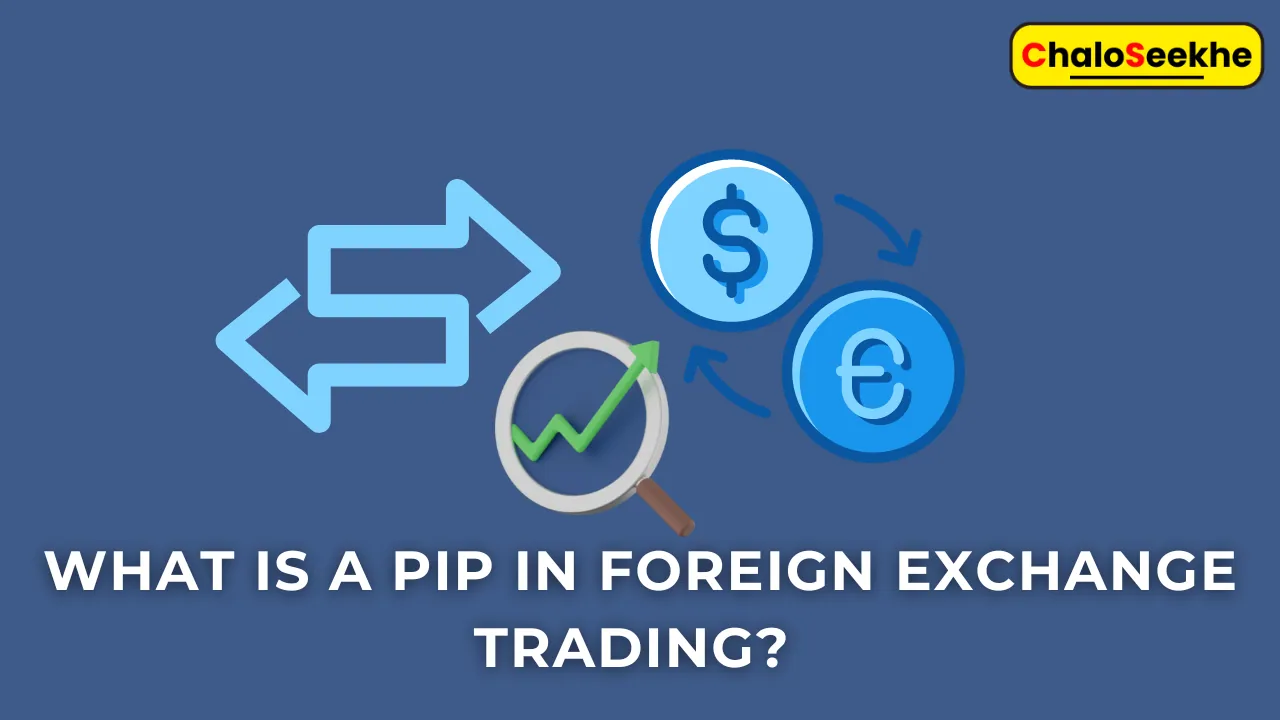In foreign exchange trading, a “pip” is a fundamental term. Traders engage in forex by exchanging currencies, with their values relative to other currencies. Quotes for these pairs are precise to four decimal places, showing bid and ask spreads. Pips gauge fluctuations in exchange rates. As most pairs are quoted with four decimals, a pip is the smallest change unit.
Here we’ll learn what is a pip in foreign exchange trading. To calculate pips in the forex market, understanding this concept is crucial.
Did you know what is a Pip?
A “Pip” in foreign exchange trading stands for “percentage in point” or “price interest point.” It is a measurement used in forex trading to quantify the change in value between two currencies. It represents the most minor standardized movement that a currency quote can undergo.
Traders utilize pips to calculate the spread between bid and ask prices of currency pairs, allowing them to gauge their position’s profit or loss. A pip is typically equivalent to the fourth decimal place (0.0001) for most major currencies.
However, exceptions exist, like the Japanese Yen, where a pip corresponds to the second digit after the decimal point. While a pip is commonly associated with the second or fourth decimal place, fractional pip values are sometimes displayed.
Pips are also employed to express the spread within a currency pair, reflecting market price fluctuations. “Point” is sometimes interchangeable with “pip” in CFD forex trades. One can explore concepts such as spreads and leverage in the forex market to gain a deeper understanding of forex trading.
What are PiPs used for?
Pips are utilized in currency trading to indicate the price movement within a currency pair’s exchange rate. They reflect the variation in value for a trade position. For example, if you purchased a currency pair at 1.1356 and sold it at 1.1360, your trade gained four pips. To determine your profit, you’d need to calculate the monetary worth of a single pip and then multiply it by your chosen trade volume.
Here are the Examples of Pip
Consider the EUR/USD currency pair as an example. If the market shifts from 1.1600 to 1.1601, this slight increase of 0.0001 is referred to as a single pip movement.
Imagine you took a long position on EUR/USD; the market’s movement was from 1.1600 to 1.1650. You would have gained 50 pips in this case, profiting from the upward movement. Conversely, if the market moved against your position, dropping from 1.1600 to 1.1550, the loss would be 50 pips.
Switching to the USD/JPY currency pair, a change from 120.01 to 120.02 would represent a movement of just one pip.
Suppose you decided to go long on this pair, and the price increased from 120.00 to 120.08. This eight-pip shift indicates that the market has moved in your favor, leading to a profitable position.
Understanding the Pip In Foreign Exchange Trading
Pip in foreign exchange trading signifies the smallest movement in currency exchange rates, represented by the fourth decimal digit in currency prices. This precise metric, known as a percentage in points (PIP), aids traders in comprehending gains and losses.
Traders should understand that PIPs reflect variations in currency prices, akin to how measurements quantify height, weight, or temperature. The bid-ask spread, the difference between the price traders pay and receive, is integral to forex trading and is measured using PIPs.
Managing risks is pivotal in forex trading, and PIPs serve as a tool to quantify potential hazards such as currency devaluation due to hyperinflation. Such fluctuations impact currency values and exchange rates, influencing the affordability of imported goods.
Another essential element of PIPs is leverage, which refers to the borrowed capital used for investment purposes. It magnifies the effect of PIPs on profits or losses, increasing volatility in trading. Forex traders profit when currency values shift, as seen when trading pairs like EUR/USD.
If a trader buys EUR/USD at 1.1029, profits only materialize when the EURO’s value surges, pushing the quoted currency beyond 1.102. In the intricate landscape of pip in foreign exchange trading, the concept of “pip” remains a cornerstone for understanding and evaluating market movements.
How to Calculate Pips in the Forex Market?
Calculating pips in the forex market depends on the currency pair, exchange rate, and trade value. When your forex account is in U.S. dollars, and USD is the second currency (the quote currency), like EUR/USD, a pip is set at 0.0001.
To find the pip value, multiply the trade value (lot size) by 0.0001. For instance, with EUR/USD, if you trade 10,000 euros, the pip value is $1. A trade buying 10,000 euros at 1.0801 and selling at 1.0811 yields a profit of 10 pips ($10).
However, if USD is the first currency (base currency), like USD/CAD, pip value considers the exchange rate. Divide pip size by the exchange rate, then multiply by the trade value.
For example, 0.0001 divided by a USD/CAD rate of 1.2829 and multiplied by 100,000 (standard lot) gives a pip value of $7.79. A trade is purchasing 100,000 USD at 1.2829 and selling at 1.2830, resulting in a profit of 1 pip ($7.79). Understanding pip calculations is crucial for managing forex trades effectively.
What is the Importance of PIP in Forex?
The significance of pip in foreign exchange trading lies in its role in risk assessment and trade decision-making. Traders rely on PIP values to gauge potential risks and anticipate currency price movements. Precisely to the fourth decimal point, PIPs provide accurate insights into price fluctuations.
This accuracy aids traders in swiftly evaluating risks associated with their trades, enabling them to make timely adjustments and prevent substantial losses. Pip values are especially advantageous due to their relevance in high-volume forex trading.
Even more precise than whole PIPs, fractional PIPs offer finer measurements.
As a universal unit for currency price changes, PIPs facilitate effective communication within the global forex market. In essence, PIPs empower traders with essential information for informed decision-making, enhancing their ability to navigate the complexities of forex trading.
Read More: Best Free AI Tools For Affiliate Marketing
What’s the difference between a Pip and a Pipette?
In the foreign exchange market, a pip serves as a standardized measurement for fluctuations in exchange rates. It signifies a change of 0.0001 (1/10,000), the smallest incremental price shift for most currency pairs. Distinct from a pip, a pipette holds a value of 1/10 of a pip.
Its purpose is quantifying changes in the fifth decimal place, denoting a fraction of 1/100,000. That’s why a pip accounts for alterations in the fourth decimal place, while a pipette precisely gauges movement in the fifth decimal place.
Know what is Spread in a Forex?
A forex spread refers to the difference between a currency pair’s bid and ask prices. In the case of EUR/USD, if the asking price is 1.1053 and the bid price is 1.1051, the spread would be 0.0002 or 2 pips.
To determine the expense of the forex spread, you should multiply the spread by your trade size or volume. For instance, if you’re trading 100,000 units of EUR/USD and facing a 2-pip spread, the spread cost would be $20.00, calculated as (0.0002 x 100,000).
Conclusion
Understanding pips is critical for forex traders because it allows them to measure the amount of their prospective earnings or losses also it consequently manage their leverage and risk. In this post also explained what PIP in Forex is and what it means, their calculation, and its significance with an example here. If you like our articles, please share them with your friends.
FAQs
What does the term “pip” mean in the context of cryptocurrency?
Ans: In the crypto market, “pips” are used to measure price changes in coins. For instance, if a cryptocurrency’s price moves from $2,401 to $2,402, it has moved one pip. Smaller cryptocurrencies sometimes use pips to measure fractions of cents movement.
How does the value of a pip in forex relate to a dollar?
Ans: Due to dynamic exchange rates, the value of a pip in forex varies between currency pairs. This causes fluctuations in the value of a pip in terms of dollars.
Can the concept of a pip be applied to stock trading?
Ans: Pips are seldom used in stock trading to describe price movements, as stocks tend to experience more significant price shifts than the foreign exchange market.
Is the concept of pips applicable to the Japanese Yen Forex rate?
Ans: Yes, the Japanese Yen Forex rate employs pips. However, the yen is an exception, as its quote typically extends two decimal places beyond the decimal point. This means a single pip for the yen is represented as .01, unlike the standard .0001 for other currency pairs.
How much value do 50 pips hold in forex trading?
Ans: The value of 50 pips in forex trading depends on the specific currency pair chosen by the trader. This could be a pair like EURUSD, EURJPY, USDCAD, or GBPAUD. The worth of 50 pips will differ based on the selected pair.


